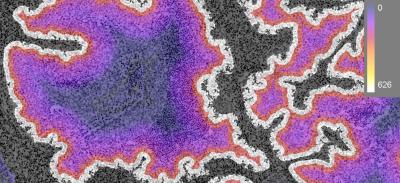
Heatmap of lung cancer tissue section depicting number of CD3+ cells as a function of distance into the tumor.
In the United States lung cancer accounts for approximately 140,000 deaths annually and is the third most common cancer. Lung cancer is divided into two main types; small cell lung cancer and the more common non-small cell lung cancer of which lung adenocarcinoma is a subtype and accounts for approximately 50% of all lung cancers. Lung adenocarcinomas (LADC) are particularly difficult to treat, likely due to their heterogenous nature. The majority of LADCs consist of multiple histological subtypes, which can include lepidic, papillary, acinar, micropapillary, and solid. Attempts to understand the formation of this histological heterogeneity indicated no direct relationship between the heterogeneity and specific genetic alterations leading researchers to explore tumor environment as a possible factor.
TGFβ Signaling Activated by Cancer-Associated Fibroblasts Determines the Histological Signature of Lung Adenocarcinoma
In a study entitled, “TGFβ Signaling Activated by Cancer-Associated Fibroblasts Determines the Histological Signature of Lung Adenocarcinoma” researchers explored the influence of the tumor microenvironment on the development of histological subtypes. Both in vivo and in vitro culture of tumor cells were assessed. The in vivo placement of A549 tumors in immunodeficient mice showed distinctive histological features based on placement location within the mouse. To lend further credence to the idea that microenvironment plays a role in cell phenotype, solid- and acinar-typed tumors were removed and reinjected into different regions in mice where transitions from solid-to-acinar (SAT) or from acinar-to-solid (AST) were observed. The researchers then focused on the acinar-type tumors which have a stromal cell-type component, these cancer-associated fibroblasts were isolated, immortalized and used as a component of in vitro work to better understand the cellular mechanisms that underlie the cell subtype transitions.
The in vitro work examined three lung cancer cell lines (A459, Calu-3 and NCI-H292) and utilized the Visikol HISTO tissue-clearing technique for immunofluorescent labeling and clearing of tumor colonies. The lung cancer cells were cultured alone or co-cultured with cancer-associated fibroblasts (CAFs) to better elucidate the role of CAFs in formation of the acinar cell subtype. All three co-culture models revealed gland-like structures compared to models with cancer cells alone indicating SAT induction in the co-culture model. Additional analysis via RNA-sequencing was performed to further delve into the molecular mechanisms behind this phenomenon. Gene expression analysis showed increased levels of genes related to the TGFβ signaling pathway. Using this information, the in vitro co-culture model using CAFs and A549s were treated with siRNA or inhibitors related to TGFβ signaling and both methods showed decreases in acinar formation indicating a key role of TGFβ signaling in the induction of the acinar subtype through SAT. A better understanding of tumor heterogeneity in lung adenocarcinomas is crucial to the development of effective therapeutics and diagnostic criteria and this research paves the way for a more focused approach to targeting specific LADC subtypes.
As a leader in advanced cell culture and imaging, Visikol offers products and services can be used to evaluate cancer progression and therapeutics. Reach out today to learn more about how Visikol can help you drive science forward!
